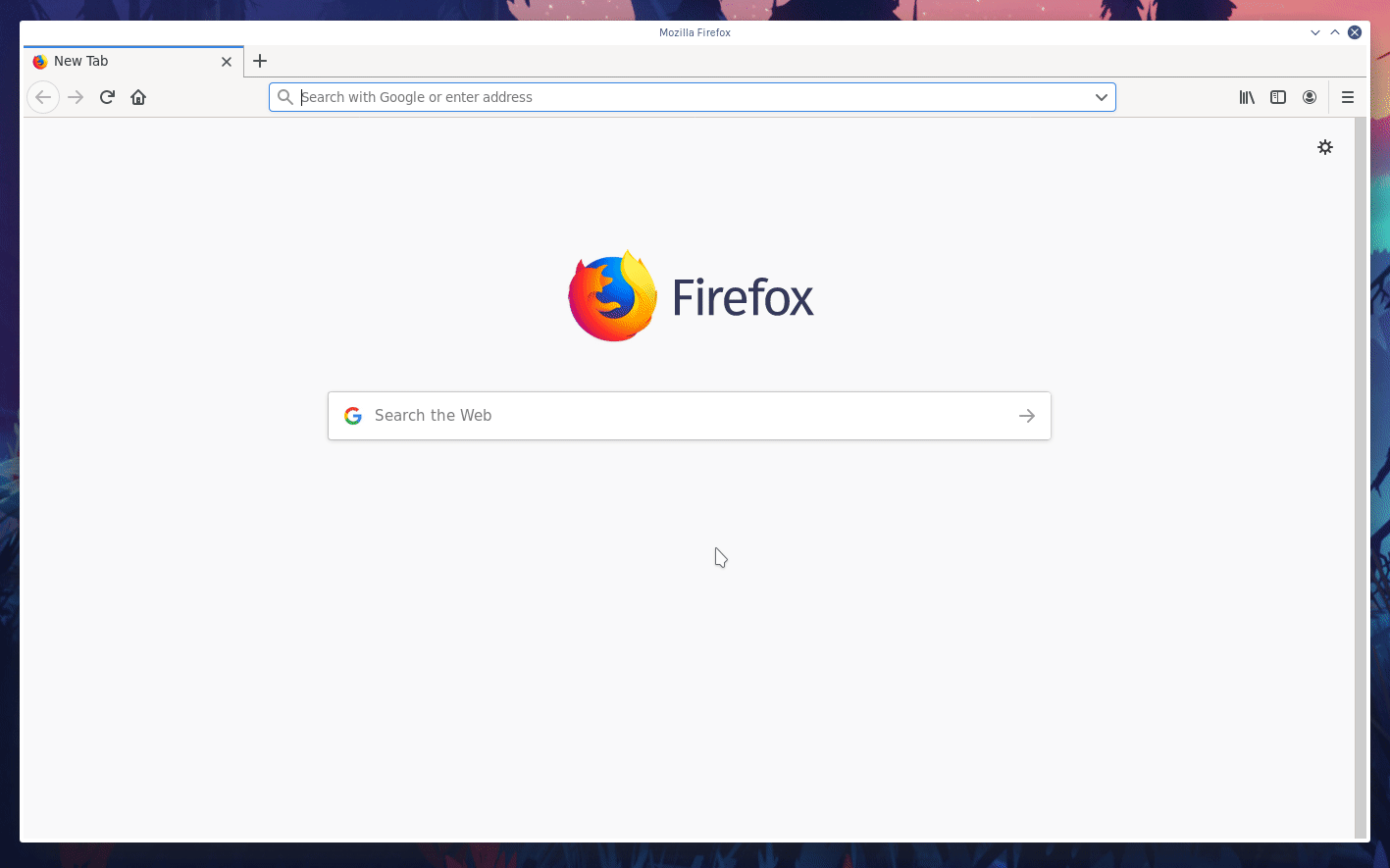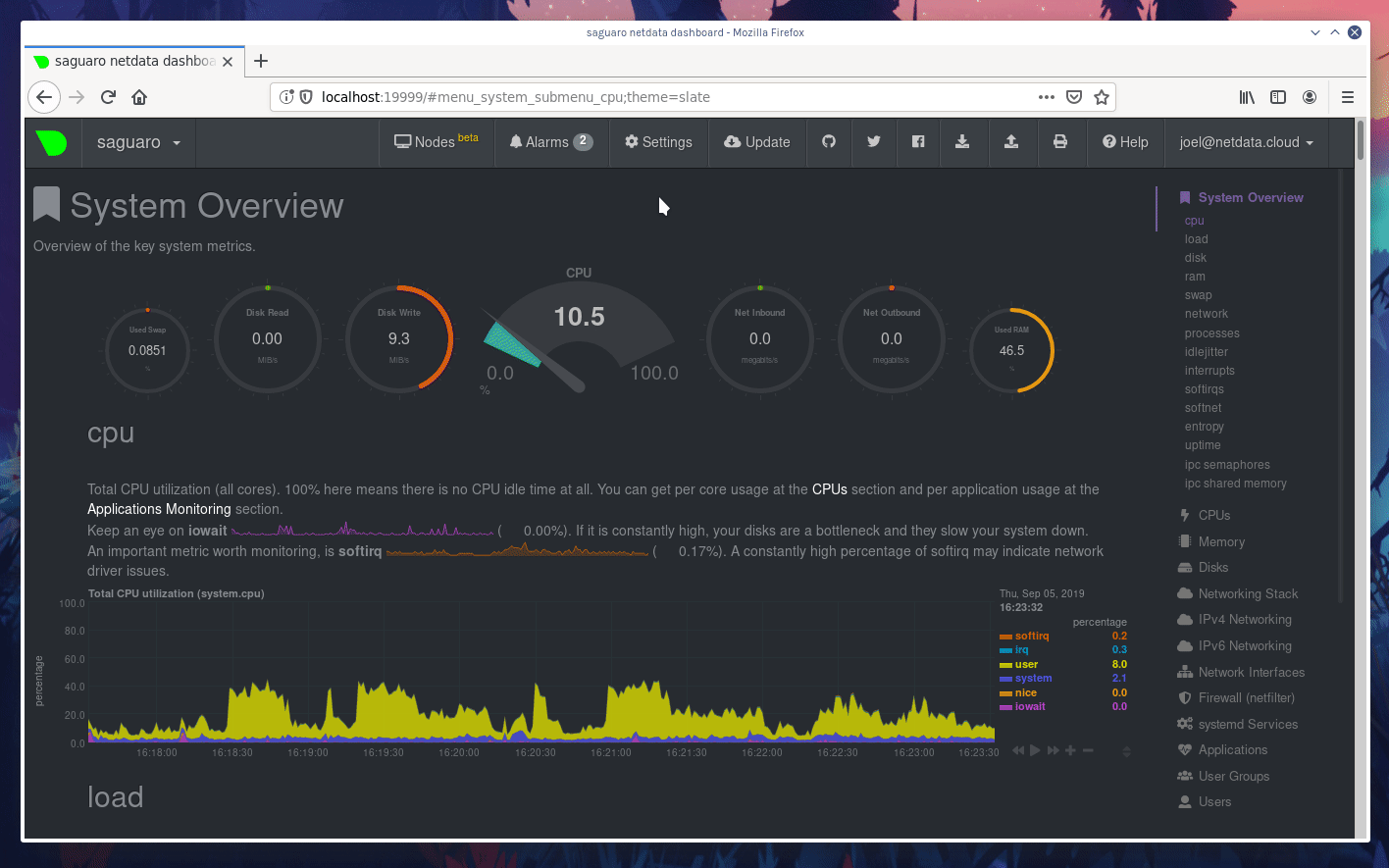diff options
Diffstat (limited to '')
| -rw-r--r-- | docs/getting-started.md | 233 |
1 files changed, 233 insertions, 0 deletions
diff --git a/docs/getting-started.md b/docs/getting-started.md new file mode 100644 index 00000000..ce355819 --- /dev/null +++ b/docs/getting-started.md @@ -0,0 +1,233 @@ +# Getting started guide + +Thanks for trying Netdata! In this guide, we'll quickly walk you through the first steps you should take after getting +Netdata installed. + +Netdata can collect thousands of metrics in real-time without any configuration, but there are some valuable things to +know to get the most of out Netdata based on your needs. + +> If you haven't installed Netdata yet, visit the [installation instructions](../packaging/installer) for details, +> including our one-liner script, which automatically installs Netdata on almost all Linux distributions. + +## Access the dashboard + +Open up your web browser of choice and navigate to `http://YOUR-HOST:19999`. Welcome to Netdata! + + + +**What's next?**: + +- Read more about the [standard Netdata dashboard](../web/gui/). +- Learn all the specifics of [using charts](../web/README.md#using-charts) or the differences between [charts, + context, and families](../web/README.md#charts-contexts-families). + +## Configuration basics + +Netdata primarily uses the `netdata.conf` file for custom configurations. + +On most systems, you can find that file at `/etc/netdata/netdata.conf`. + +> Some operating systems will place your `netdata.conf` at `/opt/netdata/etc/netdata/netdata.conf`, so check there if +> you find nothing at `/etc/netdata/netdata.conf`. + +The `netdata.conf` file is broken up into various sections, such as `[global]`, `[web]`, `[registry]`, and more. By +default, most options are commented, so you'll have to uncomment them (remove the `#`) for Netdata to recognize your +change. + +Once you save your changes, [restart Netdata](#start-stop-and-restart-netdata) to load your new configuration. + +**What's next?**: + +- [Change how long Netdata stores metrics](#change-how-long-netdata-stores-metrics) by either increasing the `history` + option or switching to the database engine. +- Move Netdata's dashboard to a [different port](https://docs.netdata.cloud/web/server/) or enable TLS/HTTPS + encryption. +- See all the `netdata.conf` options in our [daemon configuration documentation](../daemon/config/). +- Run your own [registry](../registry/README.md#run-your-own-registry). + +## Collect data from more sources + +When Netdata _starts_, it auto-detects dozens of **data sources**, such as database servers, web servers, and more. To +auto-detect and collect metrics from a service or application you just installed, you need to [restart +Netdata](#start-stop-and-restart-netdata). + +> There is one exception: When Netdata is running on the host (as in not in a container itself), it will always +> auto-detect containers and VMs. + +However, auto-detection only works if you installed the source using its standard installation procedure. If Netdata +isn't collecting metrics after a restart, your source probably isn't configured correctly. Look at the [external plugin +documentation](../collectors/plugins.d/) to find the appropriate module for your source. Those pages will contain more +information about how to configure your source for auto-detection. + +Some modules, like `chrony`, are disabled by default and must be enabled manually for auto-detection to work. + +Once Netdata detects a valid source of data, it will continue trying to collect data from it. For example, if +Netdata is collecting data from an Nginx web server, and you shut Nginx down, Netdata will collect new data as soon as +you start the web server back up—no restart necessary. + +### Configuring plugins + +Even if Netdata auto-detects your service/application, you might want to configure what, or how often, Netdata is +collecting data. + +Netdata uses **internal** and **external** plugins to collect data. Internal plugins run within the Netdata dæmon, while +external plugins are independent processes that send metrics to Netdata over pipes. There are also plugin +**orchestrators**, which are external plugins with one or more data collection **modules**. + +You can configure both internal and external plugins, along with the individual modules. There are many ways to do so: + +- In `netdata.conf`, `[plugins]` section: Enable or disable internal or external plugins with `yes` or `no`. +- In `netdata.conf`, `[plugin:XXX]` sections: Each plugin has a section for changing collection frequency or passing + options to the plugin. +- In `.conf` files for each external plugin: For example, at `/etc/netdata/python.d.conf`. +- In `.conf` files for each module : For example, at `/etc/netdata/python.d/nginx.conf`. + +It's complex, so let's walk through an example of the various `.conf` files responsible for collecting data from an +Nginx web server using the `nginx` module and the `python.d` plugin orchestrator. + +First, you can enable or disable the `python.d` plugin entirely in `netdata.conf`. + +```conf +[plugins] + # Enabled + python.d = yes + # Disabled + python.d = no +``` + +You can also configure the entire `python.d` external plugin via the `[plugin:python.d]` section in `netdata.conf`. +Here, you can change how often Netdata uses `python.d` to collect metrics or pass other command options: + +```conf +[plugin:python.d] + update every = 1 + command options = +``` + +The `python.d` plugin has a separate configuration file at `/etc/netdata/python.d.conf` for enabling and disabling +modules. You can use the `edit-config` script to edit the file, or open it with your text editor of choice: + +```bash +sudo /etc/netdata/edit-config python.d.conf +``` + +Finally, the `nginx` module has a configuration file called `nginx.conf` in the `python.d` folder. Again, use +`edit-config` or your editor of choice: + +```bash +sudo /etc/netdata/edit-config python.d/nginx.conf +``` + +In the `nginx.conf` file, you'll find additional options. The default works in most situations, but you may need to make +changes based on your particular Nginx setup. + +**What's next?**: + +- Look at the [full list of data collection modules](Add-more-charts-to-netdata.md#available-data-collection-modules) + to configure your sources for auto-detection and monitoring. +- Improve the [performance](Performance.md) of Netdata on low-memory systems. +- Configure `systemd` to expose [systemd services + utilization](../collectors/cgroups.plugin/README.md#monitoring-systemd-services) metrics automatically. +- [Reconfigure individual charts](../daemon/config/README.md#per-chart-configuration) in `netdata.conf`. + +## Health monitoring and alarms + +Netdata comes with hundreds of health monitoring alarms for detecting anomalies on production servers. If you're running +Netdata on a workstation, you might want to disable Netdata's alarms. + +Edit your `/etc/netdata/netdata.conf` file and set the following: + +```conf +[health] + enabled = no +``` + +If you want to keep health monitoring enabled, but turn email notifications off, edit your `health_alarm_notify.conf` +file with `edit-config`, or with your the text editor of your choice: + +```bash +sudo /etc/netdata/edit-config health_alarm_notify.conf +``` + +Find the `SEND_EMAIL="YES"` line and change it to `SEND_EMAIL="NO"`. + +**What's next?**: + +- Write your own health alarm using the [examples](../health/README.md#examples). +- Add a new notification method, like [Slack](../health/notifications/slack/). + +## Change how long Netdata stores metrics + +By default, Netdata stores 1 hour of historical metrics and uses about 25MB of RAM. + +If that's not enough for you, Netdata is quite adaptable to long-term storage of your system's metrics. + +There are two quick ways to increase the depth of historical metrics: increase the `history` value for the round-robin +that's enabled by default, or switch to the database engine. + +We have a tutorial that walks you through both options: [**Changing how long Netdata stores +metrics**](../docs/tutorials/longer-metrics-storage.md). + +**What's next?**: + +- Learn more about the [memory requirements for the database engine](../database/engine/README.md#memory-requirements) + to understand how much RAM/disk space you should commit to storing historical metrics. +- Read up on the memory requirements of the [round-robin database](../database/), or figure out whether your system + has KSM enabled, which can [reduce the default database's memory usage](../database/README.md#ksm) by about 60%. + +## Monitoring multiple systems with Netdata + +If you have Netdata installed on multiple systems, you can have them all appear in the **My nodes** menu at the top-left +corner of the dashboard. + +To show all your servers in that menu, you need to [register for or sign in](../docs/netdata-cloud/signing-in.md) to +[Netdata Cloud](../docs/netdata-cloud/) from each system. Each system will then appear in the **My nodes** menu, which +you can use to navigate between your systems quickly. + + + +Whenever you pan, zoom, highlight, select, or pause a chart, Netdata will synchronize those settings with any other +agent you visit via the My nodes menu. Even your scroll position is synchronized, so you'll see the same charts and +respective data for easy comparisons or root cause analysis. + +You can now seamlessly track performance anomalies across your entire infrastructure! + +**What's next?**: + +- Read up on how the [Netdata Cloud registry works](../registry/), and what kind of data it stores and sends to your + web browser. +- Familiarize yourself with the [Nodes View](../docs/netdata-cloud/nodes-view.md) + +## Start, stop, and restart Netdata + +When you install Netdata, it's configured to start at boot, and stop and restart/shutdown. You shouldn't need to start +or stop Netdata manually, but you will probably need to restart Netdata at some point. + +- To **start** Netdata, open a terminal and run `service netdata start`. +- To **stop** Netdata, run `service netdata stop`. +- To **restart** Netdata, run `service netdata restart`. + +The `service` command is a wrapper script that tries to use your system's preferred method of starting or stopping +Netdata based on your system. But, if either of those commands fails, try using the equivalent commands for `systemd` +and `init.d`: + +- **systemd**: `systemctl start netdata`, `systemctl stop netdata`, `systemctl restart netdata` +- **init.d**: `/etc/init.d/netdata start`, `/etc/init.d/netdata stop`, `/etc/init.d/netdata restart` + +## What's next? + +Even after you've configured `netdata.conf`, tweaked alarms, learned the basics of performance troubleshooting, and +added all your systems to the **My nodes** menu, you've just gotten started with Netdata. + +Take a look at some more advanced features and configurations: + +- Centralize Netdata metrics from many systems with [streaming](../streaming) +- Enable long-term archiving of Netdata metrics via [backends](../backends) to time-series databases. +- Improve security by putting Netdata behind an [Nginx proxy with SSL](Running-behind-nginx.md). + +Or, learn more about how you can contribute to [Netdata core](../CONTRIBUTING.md) or our +[documentation](../docs/contributing/contributing-documentation.md)! + +[](<>) |
